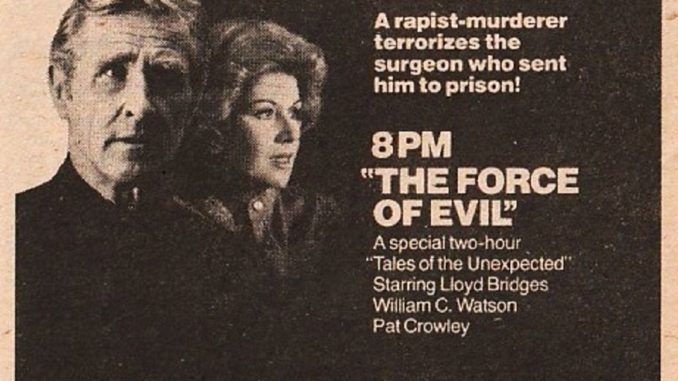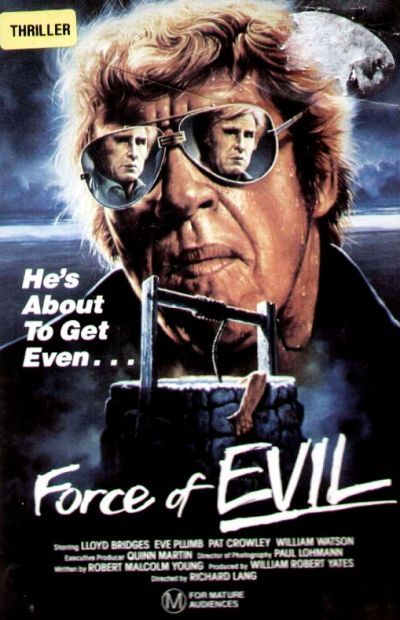
Rating: C-
Dir: Richard Lang
Star: Lloyd Bridges, William Watson, Pat Crowley, Eve Plumb
This has a lot in common with Cape Fear, and interestingly, manages to split the difference in time almost exactly between the 1962 original and the 1992 remake. Of course, it lacks the genuinely scary presence of either: Watson is no match for either Robert – Mitchum or De Niro – and I suspect he’ll probably also fall short of the upcoming series on Apple TV, starring Javier Bardem. But for a TVM, originally just a feature-length episode of Quinn Martin’s Tales of the Unexpected, it’s adequate. The series, which aired in the UK as Twist in the Tale to avoid confusion with Roald Dahl’s series of the Unexpected name, had eight episodes, with this the only one to last two hours.
It sees murderer/rapist Teddy Jakes (Watson) return to the small town, where he previously worked in the hospital run by Dr. Yale Carrington (Bridges). When Yale declines to give Teddy his old job back, veiled threats are made, and Teddy takes up residence in an abandoned motel. Yale’s brother is the local sheriff, but is unable to do anything about Teddy’s campaign of terror, since he’s careful to leave no evidence that can be used against him. Eventually, the doctor uses Teddy’s diabetes against him instead, disposing of the body down a remote well. Except – and this supernatural element of an apparently unstoppable killer, a year before Halloween, is where it does diverge from Cape Fear – it barely slows the killer down.
 Naturally, it all ends in a trap being laid, while Yale’s wife Maggie (Crowley) and teenage daughter Cindy (Plumb) hide out on his boat, only for Teddy to show up there. There’s an interesting discussion between mother and daughter, where the former says, “According to the law, he hasn’t done anything. But there’s a much older law, one that people follow when they have no other choice. Protecting one’s family is… well, it’s the first law.” I wish the film had delved deeper into this mind-set, and also gone further down the supernatural route, making it clearer. Instead, Teddy’s apparent immortality feels more like sloppy writing, deserving of being filed alongside his easy access to severed limbs (!) for the purposes of terroristic threats.
Naturally, it all ends in a trap being laid, while Yale’s wife Maggie (Crowley) and teenage daughter Cindy (Plumb) hide out on his boat, only for Teddy to show up there. There’s an interesting discussion between mother and daughter, where the former says, “According to the law, he hasn’t done anything. But there’s a much older law, one that people follow when they have no other choice. Protecting one’s family is… well, it’s the first law.” I wish the film had delved deeper into this mind-set, and also gone further down the supernatural route, making it clearer. Instead, Teddy’s apparent immortality feels more like sloppy writing, deserving of being filed alongside his easy access to severed limbs (!) for the purposes of terroristic threats.
The other problem is Bridges; albeit, this is one of those cases where, “It’s not you, it’s me” is appropriate. Because I can’t look at him without thinking of his performances a few years later, in the likes of Airplane! I couldn’t take Bridges’s character seriously, weakening the impact of the film’s efforts to generate tension. I kept expecting the doctor to come out with something like, “It’s a big building with patients, but that’s not important right now.” Yes, I know that was Leslie Nielsen. Work with me here, dammit. The movie succeeds at least somewhat better when he is off-screen, such as the scene where Teddy is talking to Cindy, and she has no idea who he is. Not one to stick in your mind though.
